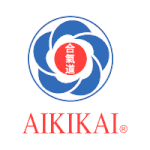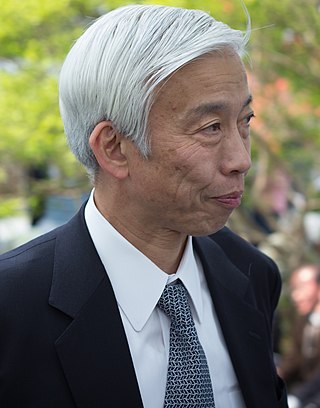
Moriteru Ueshiba is a Japanese master of aikido. He is a grandson of Morihei Ueshiba, founder of aikido, and son of Kisshomaru Ueshiba. Ueshiba is the third and current Doshu of the Aikikai.
Morihiro Saito was a teacher of the Japanese martial art of aikido, with many students around the world. Saito's practice of aikido spanned 56 years, from the age of 18, when he first met aikido founder Morihei Ueshiba, until his death in 2002.
Kisshomaru Ueshiba was a prominent Japanese master of aikido. He was the son of Morihei Ueshiba, founder of aikido, and became the international leader of aikido after his father's death.

Christian Tissier is one of the best known European aikido teachers, who pioneered the art in France. He started his Aikido training in 1962 as a child in Jean-Claude Tavernier's Dojo in Paris, following the style of Hiroo Mochizuki. He soon went on to train under Mutsuro Nakazono and was awarded by him the 2nd dan before leaving for Tokyo in 1969. He came to the Aikikai Hombu Dojo as an 18-year-old, and trained there for seven years. Among the teachers that have inspired him are Seigo Yamaguchi, Kisaburo Osawa and the second doshu Kisshomaru Ueshiba. While living in Tokyo, he also trained in Kenjutsu under Minoru Inaba at the Shiseikan and in Kickboxing at the Mejiro Gym. He also worked as a model and taught French language at a school and Institut Franco-japonais de Tokyo.
The Iwama Dōjō is a dōjō built by the founder of aikido, Morihei Ueshiba, who lived there from 1942 until his death in 1969. It is located in the former town of Iwama and became an important historical location for the development of aikido and "a Mecca to the aikido community." This dojo is also where Morihiro Saito, one of the founder's closest students, learned and taught aikido from 1946 until 2002 developing what is often referred to as the Iwama Style.

Koichi Tohei was a 10th Dan aikidoka and founder of the Ki Society and its style of aikido, officially Shin Shin Toitsu Aikido, but commonly known as Ki-Aikido.

Kazuo Chiba was a Japanese aikido teacher and founder of Birankai International. He served for seven years as uchideshi at the Aikikai Hombu Dojo before being dispatched abroad to help develop Aikido internationally. He held an 8th dan in Aikido, issued by Aikikai world headquarters in Tokyo, Japan and was active in Aikido for over 50 years.
Benjamin G. Galarpe is considered to be the father of Aikido in the Philippines. He began training in 1957 in Guam under Harry S. Ito. Four years later he earned his Shodan (rank) degree from the Japan Aikido Hombu Dojo. He was the first Aikido representative of the Japan Aikikai Hombu Dojo to spread and propagate Aikido in the Philippines. Morihei Ueshiba, the founder of Aikido, promoted him to the degree of Nidan after advanced training in the World Aikido Hombu in Sanjukuku, Tokyo, Japan. While teaching in the Philippines, he held exhibitions in Bicol, Pampanga, Baguio, Olongapo City, Clark Air Base in Angeles City, Cebu City, Batangas City, and other places within the Philippines. Benjamin Galarpe's students, namely Chan Hok-seng, Ernesto Talag, Max Tian and Manuel "Omar" Camar, became the prime movers of the Aikido Movement in the Philippines.
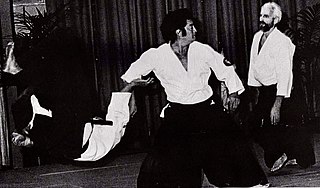
Yoshimitsu Yamada was a Japanese-American aikido instructor. He was ranked eighth dan in the Aikikai. He was chief instructor at the dojo New York Aikikai, and president of the United States Aikido Federation (USAF).
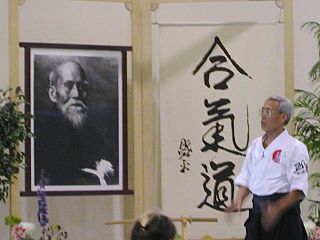
Mitsugi Saotome is a Japanese aikido teacher currently living in the United States. He was a direct disciple of the founder of aikido, Morihei Ueshiba.
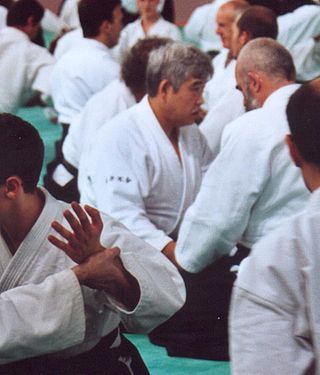
Toshirō Suga is a Japanese aikido instructor. He holds the rank of 7th dan Aikikai.
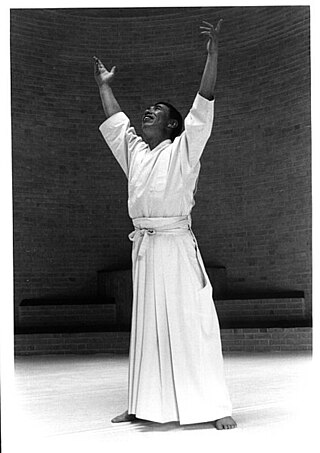
Masamichi Noro is the founder of Kinomichi and was an uchi-deshi of Morihei Ueshiba, the founder of Aikido.
Kisaburo Osawa was an influential aikido teacher who taught for many years at the Aikikai Hombu Dojo and was a close advisor to Kisshomaru Ueshiba.
Though the art of aikido is characteristically different from other Japanese martial arts, it has a variety of identifiable styles within the family of organizations descending from the teachings of Morihei Ueshiba.
Mitsuteru Ueshiba is the son of the current Aikido Dōshu, Moriteru Ueshiba. In keeping with the iemoto system, he is expected to succeed his father as Dōshu. He is the great-grandson of Morihei Ueshiba, the Aikido founder.

The Aikido Schools of Ueshiba (ASU) is a not-for-profit Aikido organization founded by Mitsugi Saotome Shihan upon moving from Japan to the United States in 1975. It is a federation of about 110 Dojos throughout North America.
William Gleason is the American author of two books about aikido, spirituality and kototama. He holds the rank of 7th dan in aikido and is the founder and head instructor of Shobu Aikido in Somerville, MA, USA. Gleason teaches seminars worldwide.
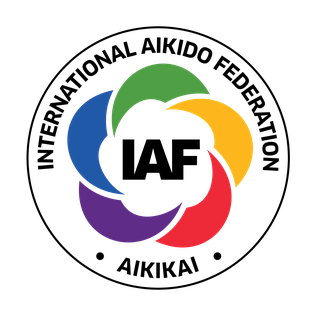
International Aikido Federation (IAF) is a world governing body for the sport of Aikido.
Hiroshi Kato; was an Aikido Master. He lived in Tokyo, Japan, and travelled the world teaching the principles of Aikido. A former student of Morihei Ueshiba, Sensei Kato taught from 1986 onwards in his Dojo "Suginami Aikikai" located in the Ogikubo district of Tokyo and has over 55 students.

Stanley A. Pranin was an American martial artist, founding publisher, and editor-in-chief of Aikido Journal. Pranin, a researcher and archivist of aikido, has written and published several books and many articles about aikido, Daito-ryu Aikijujutsu, and Morihei Ueshiba and was an influential figure in the aikido world.
